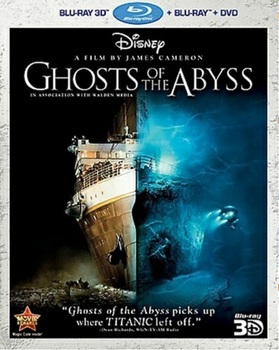Ghosts of the Abyss: The Other James Cameron Titanic Film
If you see only one James Cameron-directed movie about the Titanic — and you should — see the one that doesn’t star Kate and Leo.

As haunting as its name, Ghosts of the Abyss (newly released on Blu-ray) is a deep-sea documentary, co-produced by Disney and Walden Media, that uses diving vessels and remote-controlled robot cameras to offer an unprecedented close-up look at the wreck of the Titanic, including extraordinary interior shots. Bill Paxton, who played a fictional Titanic seeker in Cameron’s better-known film, is along for the ride, and acts as narrator and viewer surrogate.
Computer-generated images and photographs of the original ship provide context to the images of waterlogged ruins, and restrained effects bring back the “ghosts,” with images of actors in period dress recreating scenes from the voyage superimposed onto the wreckage.
These techniques are effective, but what is most memorable are the images of the wreckage itself, and especially the artifacts in it — some unrecognizable, like the encrusted masses in the cargo hold where they hoped to find the Renault automobile made famous in Titanic’s sex scene; others astonishingly preserved: a carafe and a glass on a shelf, unbroken by the fall to the ocean floor; a brass bed that might have been Molly Brown’s.
One of the best images takes both robot cameras to film: the colors of the lead-lined stained glass of the ship’s dining room, filmed by one camera while the other floods them with light from behind. “Not since April 14, 1912 had human eyes seen light pouring through these beautiful windows,” Paxton observes.
Gratifyingly, moral reflection honors the heroism and lessons of the Titanic story in all the ways Cameron’s blockbuster doesn’t. It’s gratifying, though also slightly maddening, to hear Cameron’s crew discussing the heroism as well as the cowardice displayed that night, in stark contrast to Titanic, which highlighted the venality and robbed the tragedy’s heroic acts of their luster.
Specifically called out are the heroism of the engine crew, who risked (and ultimately lost) their lives to keep the generators running as long as possible for the sake of the lifeboat winches and the telegraphed S.O.S.’s, and of the band playing on deck to help maintain calm. (In Titanic Cameron depicts the band concluding that no one is listening to them anyway, but continuing playing for lack of anything better to do.)
We also learn that an officer on the port side of the ship permitted only women and children onto the lifeboats, while on the other side First Officer William Murdoch (wrongly maligned in Titanic, as Cameron has since admitted) seated all comers, regardless of sex or class. It’s hard to fault either approach, especially when Cameron notes that almost two-thirds of the survivors “have Murdoch to thank for it.”
Surreally, the filmmakers surface from diving one day to discover that the world has changed: September 11, 2001 took place during the shoot. At first the shock of world events overshadows the expedition, yet in time it becomes clear that the coincidence oddly fitting: In some ways September 11 is our age’s Titanic story: a unthinkable, enduring tragedy in which warning signs were missed and an entire generation is confronted with fundamental questions of life and death.
Paxton has Ghosts of the Abyss’s most memorable line: “Titanic is like a stage where God tells you, ‘You have two hours to play out the rest of your life. What will you be? Will you be a hero? Will you be a coward?’”
That, to me, is the most compelling angle on the Titanic story. I will always regret that that the one movie that continues to define the Titanic tragedy in the popular imagination scuttled this question and the moral universe it implies in favor of a shallow tale of first love and youthful rebellion.
Recent
- Benoit Blanc goes to church: Mysteries and faith in Wake Up Dead Man
- Are there too many Jesus movies?
- Antidote to the digital revolution: Carlo Acutis: Roadmap to Reality
- “Not I, But God”: Interview with Carlo Acutis: Roadmap to Reality director Tim Moriarty
- Gunn’s Superman is silly and sincere, and that’s good. It could be smarter.
Home Video
Copyright © 2000– Steven D. Greydanus. All rights reserved.